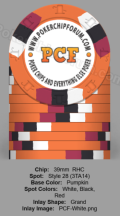Rush4Rod
High Hand
Where can I find what all the edge spot size and placement codes mean. Most are obvious to me. but others I can't figure out. For example, in 3TA316 I assume (but could me wrong) that the first 3 means 3 groups of spots on the chip and 316 means each individual spot in the groups is 3/16" but letters mean confound me?

 Based on these 2 example:
Based on these 2 example:

 {What do the letters D & TA mean (and all the other letters for that matter)?}
{What do the letters D & TA mean (and all the other letters for that matter)?}
Please advise and thanks in advance. BTW, I wonder if this community ever gets tired of being so f***in' awesome.
Rod
So, would the yellow chip from the set I'm designing be a 4TA18?Please advise and thanks in advance. BTW, I wonder if this community ever gets tired of being so f***in' awesome.
Rod


